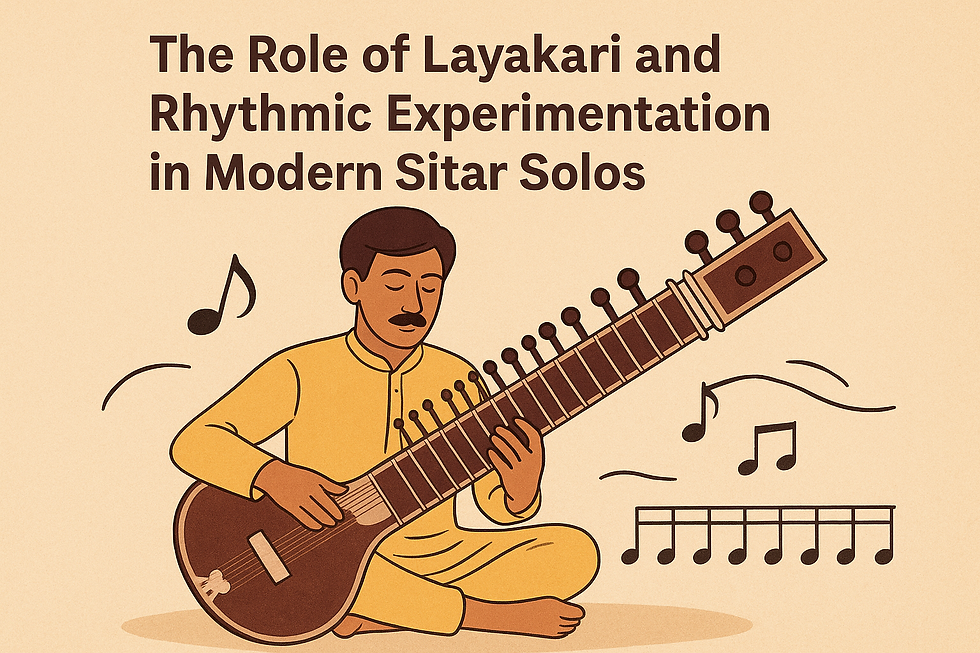"The Sitar’s Family Tree: Rabab, Veena, and a Legacy of Sound"
- Sharanya naidu
- Apr 26
- 3 min read
Updated: May 6
The sitar, with its iconic resonant sound and intricate melodic possibilities, stands today as one of the most celebrated instruments in Indian classical music. But like all cultural artifacts, it is a product of centuries of evolution, shaped by regional traditions, cross-cultural exchanges, and innovations in craftsmanship. Two instruments that played a critical role in the development of the sitar are the rabab and the veena — each lending its own structural and sonic DNA to the sitar’s eventual form.

The Rabab: A Legacy from the West
The rabab, often traced to Central Asia and Afghanistan, came to India during the medieval period, notably through the Mughal courts. Constructed traditionally with a hollow wooden body, gut strings, and often a skin-covered resonator, the rabab had a deep, warm tone suitable for both rhythmic articulation and melodic exploration.
When the rabab found its way into Indian music, particularly in the hands of Muslim musicians, it underwent transformations. It influenced the dhrupad style and was also widely used in the Sikh musical tradition, notably associated with Guru Nanak's companion Bhai Mardana. The rabab’s technique, involving plucking with a plectrum and its melodic phrasing, deeply informed how future plucked string instruments were played.
The Veena: India’s Ancient Muse
The veena, in contrast, is deeply rooted in ancient Indian tradition. Mentioned in the Vedas, and often associated with the goddess Saraswati, the veena has many variants. The one most closely linked with the sitar’s evolution is the rudra veena, a long, fretted instrument used primarily in dhrupad music.
The veena contributed significantly to the structural design of the sitar: its fretted fingerboard, sympathetic strings (tarabs), and the melodic depth achievable through meend (gliding) and gamak (oscillations) were characteristics that inspired instrument makers in northern India.
A Hybrid Innovation: Birth of the Sitar
During the medieval and early modern periods, musical traditions in India were undergoing fusion. Hindu and Muslim musical ideas interwove in courtly and devotional contexts. It was in this climate of syncretism — likely during the 13th–16th centuries — that the sitar began to emerge as a new instrument.
Instrument makers, particularly those serving royal courts, began crafting an instrument that married the fretted sophistication of the veena with the plucking technique and tonal quality of the rabab. Over time, the sitar evolved to include:
Curved, movable frets (inspired by the veena),
A long neck with a gourd resonator (like the veena),
Sympathetic strings for rich resonance,
And a plucking style using a mizrab, reminiscent of the rabab’s plectrum use.
The Sitar Takes Center Stage
By the 18th century, the sitar had solidified its identity, with musicians like Amir Khusrau (not to be confused with the 13th-century poet) and Masit Khan developing the Kharaj Pancham style. The sitar continued to evolve, especially in the hands of 20th-century maestros like Ravi Shankar and Vilayat Khan, who brought it international recognition.
Conclusion: Threads of Tradition
Understanding the sitar’s history through the lenses of the rabab and veena highlights how cultural interplay and innovation can create entirely new forms of expression. The sitar is not merely a product of Indian classical music — it is a testament to the musical conversations between South Asian tradition and Central Asian influence, between ancient ritual and courtly refinement, and between continuity and change.
As modern sitarists continue to explore the instrument’s potential across genres and cultures, they carry forward a legacy that is as hybrid as it is deeply rooted.



Comments